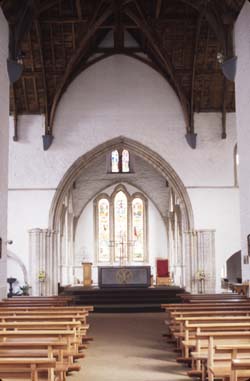 |
 |
 |
 |
 |
 |
 |
|
|
Cistercian Abbeys: DUISKE (GRAIGUENAMANAGH ) Name:
DUISKE (GRAIGUENAMANAGH) Location: Graiguenamangh
town
County: Kilkenny Graiguenamanagh, also known as Duiske abbey, was founded by William Marshal the elder, earl of Pembroke, and was colonized with monks from Stanley in Wiltshire. It is thought that the monks came to Ireland between 1202 and 1204 and first settled at Loghmere (Loughmerans) near Kilkenny, moving to Anothmolt (Annamult) and lastly to St. Saviour (Graiguenamanagh). Anothmolt was only three miles from Jerpoint and the Statutes of the Order stated that new monasteries should not be founded within twelve ‘Burgundian leagues’ of another. The site at Anothmolt was therefore illegal and inevitably led to friction with Jerpoint. In this instance the community had to move and, although the monks may not have arrived at Graiguenamangh until 1207, it seems that building may have begun in 1204 when the cemetery at Duiske was consecrated. The permanent location was in the valley of the river Barrow, on a site between the main river and the Duiske tributary. Much of the abbey was constructed with yellow limestone brought across the Irish Sea from quarries at Dundry, outside Bristol. The monastery was planned on a vast scale and the gothic church was the largest Cistercian building in Ireland. In 1228 the religious community was fixed at thirty-six monks and fifty lay-brothers; it was almost as large as Mellifont which had 50 monks and 60 lay-brothers. The abbot of Duiske sat as a peer in parliament at that time. In 1228 the abbeys of Duiske and Jerpoint entered into a long running dispute over the ownership of the dissolved monastery of Kilkenny. At the end of the thirteenth century the abbey was heavily in debt on account of forward buying on the wool market, which meant the receiving payment in advance of production. The abbey clearly struggled to fulfill its obligations and in 1299 owed approximately £466 to the Ricardi of Lucca. In 1228 Stephen of Lexington produced a comprehensive list of criticism and instructions directed at the monastic buildings of Jerpoint and Duiske – his comments are in effect a critique of the layout of these monasteries as they existed in 1228. In 1450 the abbot complained that the abbey was threatened with ruin because James, earl of Ormond, forced the monks to pay unlawful dues and had also prosecuted them. In 1460 one of the monks accidentally killed a four year old boy while practicing archery in the precinct. In 1524 the abbot gave his monastery a silver cross, gilded and decorated with gems. At the time of Dissolution the annual income
of the abbey was valued at £76 (£88 in peace time).
The value of the monastery was thus similar to the smaller Cistercian
monasteries of England, such as Buildwas and Croxden.
The abbey was suppressed in 1536 and the last abbot, Charles O’Cavanagh,
resigned his title. Following the Dissolution the property passed
to the earl of Ormond and the abbey church was used as a local
place of worship. In 1754 the church ruins were converted into
a modern
place of worship: the west end of the nave was fitted up as a Protestant
church. By 1813 the local Catholic community had taken over
the
abbey, which now forms the parish church of Graiguenamanagh town.
Some of the thirteenth-century stonework can still be seen,
including
still-leaf foliage carved into the capitals, dog-tooth ornaments,
banded shafts etc. An outstanding effigy of a knight survives
from
Graiguenamanagh; he is depicted seizing a sword and is carved with
great attention to detail. It is one of the finest medieval
effigies
in Ireland. Tiles excavated at the abbey in 1977 are among the
earliest in Ireland; it is thought that they were laid around
1250,
soon after the completion of the abbey. Guided tours of the abbey
church can be made by request only and
plaques
placed at various points around the abbey provide information on
the history of the site. Some remnants of the claustral buildings
also survive but these are
lost amongst
the
local
houses.
|
